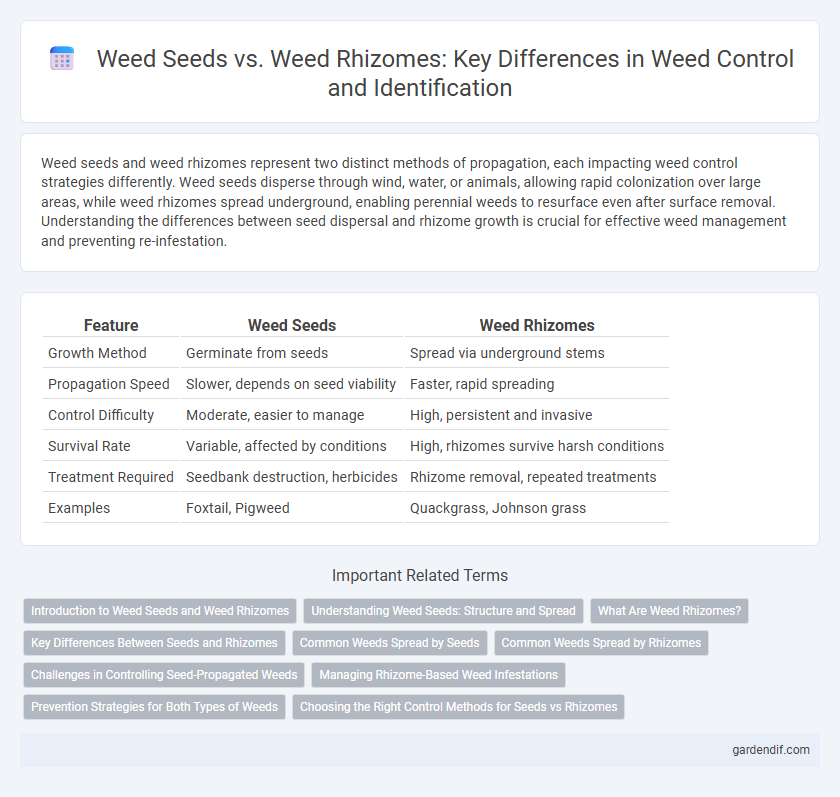
Weed seeds vs weed rhizomes Illustration
Weed seeds and weed rhizomes represent two distinct methods of propagation, each impacting weed control strategies differently. Weed seeds disperse through wind, water, or animals, allowing rapid colonization over large areas, while weed rhizomes spread underground, enabling perennial weeds to resurface even after surface removal. Understanding the differences between seed dispersal and rhizome growth is crucial for effective weed management and preventing re-infestation.
Table of Comparison
| Feature | Weed Seeds | Weed Rhizomes |
|---|---|---|
| Growth Method | Germinate from seeds | Spread via underground stems |
| Propagation Speed | Slower, depends on seed viability | Faster, rapid spreading |
| Control Difficulty | Moderate, easier to manage | High, persistent and invasive |
| Survival Rate | Variable, affected by conditions | High, rhizomes survive harsh conditions |
| Treatment Required | Seedbank destruction, herbicides | Rhizome removal, repeated treatments |
| Examples | Foxtail, Pigweed | Quackgrass, Johnson grass |
Introduction to Weed Seeds and Weed Rhizomes
Weed seeds are the primary means by which many weed species propagate, allowing them to spread over large areas through wind, water, animals, and human activity. In contrast, weed rhizomes are underground stems that enable vegetative reproduction, often resulting in rapid local expansion and difficulty in eradication due to their extensive root networks. Understanding the differences between weed seeds and rhizomes is crucial for effective weed management and control strategies.
Understanding Weed Seeds: Structure and Spread
Weed seeds are typically small, lightweight, and designed for dispersal through wind, water, or animals, allowing rapid colonization of new areas. Their structure includes protective coatings that enhance viability under various environmental conditions, ensuring long-term dormancy and germination success. Unlike weed rhizomes, seeds enable extensive genetic diversity and widespread distribution, making weed management more challenging.
What Are Weed Rhizomes?
Weed rhizomes are underground horizontal stems that enable perennial weeds to spread and regenerate rapidly, making them difficult to control. Unlike weed seeds, which primarily disperse through aboveground mechanisms, rhizomes store nutrients and produce new shoots underground, facilitating robust vegetative propagation. Understanding the biology of rhizomes is crucial for effective weed management strategies, as they require targeted control methods distinct from seed-based weed eradication.
Key Differences Between Seeds and Rhizomes
Weed seeds are reproductive structures that enable plant propagation through dispersal and germination, containing genetic material for new growth, while weed rhizomes are underground stem systems that allow vegetative reproduction and rapid colony expansion without seed formation. Seeds typically facilitate long-distance spread and genetic diversity, whereas rhizomes enable established weeds to survive harsh conditions and regrow after cutting or herbicide application. Understanding these key differences is crucial for effective weed management strategies targeting either seed prevention or rhizome disruption.
Common Weeds Spread by Seeds
Common weeds spread by seeds include dandelions, chickweed, and crabgrass, which produce large quantities of seeds capable of traveling long distances via wind, water, or animals. Weed seeds often remain dormant in soil seed banks for years, ensuring persistent infestations and rapid colonization of disturbed areas. In contrast, rhizome-spreading weeds like quackgrass and Bermuda grass propagate vegetatively but do not rely on seed dispersal for expansion.
Common Weeds Spread by Rhizomes
Common weeds spread by rhizomes include Bermuda grass, quackgrass, and johnsongrass, which propagate underground, making them difficult to eradicate. Unlike weed seeds, rhizomes store nutrients and enable rapid vegetative growth, allowing these weeds to colonize large areas efficiently. Effective management requires targeting rhizomes through deep soil cultivation and specific herbicides to prevent regrowth and spread.
Challenges in Controlling Seed-Propagated Weeds
Seed-propagated weeds pose significant challenges due to their high reproductive rates and widespread seed dispersal, resulting in rapid infestations that are difficult to predict and manage. Unlike rhizome-based weeds that spread primarily through underground stems, seed-propagated weeds often produce persistent seed banks resistant to conventional herbicides and environmental stresses. Effective control requires integrated management strategies combining pre-emergent herbicides, crop rotation, and soil seed bank disruption to reduce seed germination and long-term weed pressure.
Managing Rhizome-Based Weed Infestations
Managing rhizome-based weed infestations requires targeted strategies distinct from those used for weed seeds, as rhizomes enable rapid underground spreading and regeneration. Effective control methods include deep tillage to disrupt rhizome networks, along with systemic herbicides that translocate through rhizomes to prevent regrowth. Monitoring and repeated treatments are essential to fully eradicate rhizomatous weeds, which can otherwise survive multiple growing seasons and outcompete crops.
Prevention Strategies for Both Types of Weeds
Preventing weed growth requires targeted strategies for both weed seeds and rhizomes. For weed seeds, soil solarization, mulching, and timely application of pre-emergent herbicides can effectively reduce seed germination. Controlling weed rhizomes demands thorough soil cultivation to disrupt underground stems, combined with the use of systemic herbicides to eradicate established rhizome networks.
Choosing the Right Control Methods for Seeds vs Rhizomes
Weed seeds require control strategies such as pre-emergent herbicides and soil solarization to prevent germination, while rhizomes demand more aggressive methods like systemic herbicides and physical removal to target underground structures. Understanding the biology of weed propagation is essential; seeds disperse easily and lie dormant in soil seed banks, whereas rhizomes spread horizontally, creating dense colonies that are harder to eradicate. Effective weed management combines tailored approaches, ensuring seed control reduces future infestations and rhizome treatment eliminates established plants.
Weed seeds vs weed rhizomes Infographic

 gardendif.com
gardendif.com